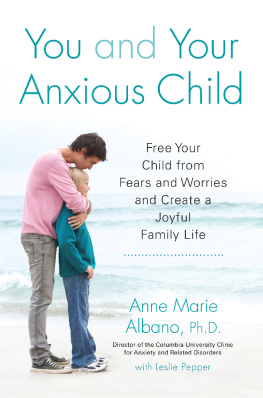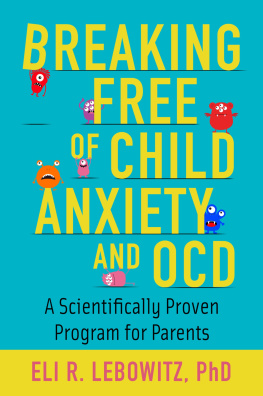

ABOUT THE AUTHOR
Lauren Callaghan (CPsychol, AFBPsS, PGDipClinPsych, PgCert, MA (hons), LLB (hons), BA) is a highly regarded clinical psychologist. She has worked at world-renowned research centres in London, UK, where she was recognized as a leading psychologist in the field of OCD, Body Dysmorphic Disorder and anxiety problems.
Lauren received further qualifications in systemic family therapy and uses her expert skillset to work with individuals and their families to overcome obsessional and anxiety problems.

A Trigger Book
Published by Welbeck Balance
An imprint of Welbeck Publishing Group
20 Mortimer Street
London W1T 3JW
First published by Welbeck Balance in 2021
Copyright Lauren Callaghan, 2021
Lauren Callaghan has asserted her right under the Copyright, Designs and Patents Act, 1988, to be identified as the Author of this work.
All rights reserved. No part of this publication may be reproduced, stored in a retrieval system, or transmitted in any form or by any means, electronically, mechanical, photocopying, recording or otherwise, without the prior permission of the copyright owners and the publishers.
A CIP catalogue record for this book is available from the British Library
US eBook ISBN: 9781789561999
UK eBook ISBN: 9781801290463
Typeset by Lapiz Digital Services
10 9 8 7 6 5 4 3 2 1

Note/Disclaimer
Welbeck Balance encourages diversity and different viewpoints. However, all views, thoughts, and opinions expressed in this book are the authors own and are not necessarily representative of Welbeck Publishing Group as an organization. All material in this book is set out in good faith for general guidance; no liability can be accepted for loss or expense incurred in following the information given. In particular, this book is not intended to replace expert medical or psychiatric advice. It is intended for informational purposes only and for your own personal use and guidance. It is not intended to diagnose, treat or act as a substitute for professional medical advice. Professional advice should be sought if desired before embarking on any health-related programme.
www.welbeckpublishing.com
To all the children and parents who have experienced anxiety and been overwhelmed by worry, especially during the lockdowns of COVID-19.
CONTENTS
INTRODUCTION
It is great that youve picked up this book. It means youve taken a positive step toward your childs recovery from anxiety and worry.
I understand that, as a parent, it is very difficult to watch your child suffering from anxiety. Your immediate desire is likely to respond in a way that removes the anxiety completely. However, as you read this book, youll learn that anxiety is, in fact, normal. It is natures way of responding to a threat, and it prompts the fight, flight or freeze mechanism (explained in more detail later), which is very useful in difficult situations.
You are by no means alone. Up to 10 per cent of all children experience anxiety problems.
If youre the parent of a child who is experiencing anxiety, you are by no means alone. Up to 10 per cent of all children experience anxiety problems. For most children, anxiety is only fleeting a response to giving a talk in class or a trip to the dentist, for example. For others, it is a severe issue; a persistent, chronic problem that negatively affects many parts of their lives.
You may be unsure about how to help your child or how best to approach conversations about anxiety with them. You might have spotted some behaviours in your child that concern you or want to know the signs to look out for when anxiety begins to become a problem. This book will help you to navigate each of these roads and will provide a stable companion as you and your child tackle their worry and anxiety together.
Please do not blame yourself if your child experiences problems with anxiety.
TIP
It is normal, as a parent, to feel guilty for the part you think you have played in causing your childs anxiety.
However, please do not blame yourself. It is not helpful for you or them, and it wont help your child overcome it.
Anxiety problems develop for many reasons and they are very common. The best thing you can do is decide to help your child overcome their anxiety problem.
WHAT ARE WORRY AND ANXIETY?
In simple terms:
Worry is when we dwell on things that we believe are threatening to us in some way. We keep thinking about these things and may go over and over them in our heads. Worry is usually based on things that havent actually happened, so we often worry about what might happen.
Another type of problem associated with worry is when we cant stop thinking about things that have happened in the past, and we go over and over them in our head, causing us to feel anxious and upset. These past events are usually unpleasant experiences and can lead to worry about them happening again.
Anxiety is a physical and emotional response to worry to something we consider to be threatening. We all experience anxiety at some point in our lives. When we feel anxious, this affects how our body responds, known as the fight, flight or freeze response. This is a very human, very normal way of responding when we feel under threat.
The words anxiety, fear and worry are often used interchangeably, but here are the definitions of how I use these terms in this book:
Worries are the thoughts we have about a future event, real or imagined, that scare us. Or they can be about things that have already happened that we cant change.
Fear is the emotional reaction to real or perceived imminent danger.
Anxiety describes the emotional and physiological sensations that we have in response to what we anticipate as a threat.
UNDERSTANDING ANXIETY
Anxiety is a perfectly natural response to threatening situations, and we all experience it from time to time. It is a fundamental part of being human; we cannot banish it permanently just because at some points in our lives it misfires and becomes a problem. What we can do instead is manage it so that it doesnt become a bigger problem than it needs to be.
It is only by understanding anxiety and worry that your child will ever learn to manage them, and stop them severely impacting their life.
The biggest lesson to teach your child is not to fight or run away from worries. Instead, they should know them for what they are, accept they are a normal part of life, and by doing so, learn to manage them.
Children who experience troubling or anxious thoughts can feel incredibly weighed down, isolated and confused. It is only by understanding anxiety and worry that your child will ever learn to manage them, and stop them severely impacting their life.
Think about it like jumping off a diving board. At first, the fear you have as you stand above the drop feels overwhelming, but then you jump and realize that it wasnt quite as bad as you thought it was going to be. Then you do it again, and again, and each time you do it, you feel less and less fear.
That is how you can help your child tackle anxiety and worry by taking steps to face it and accepting some level of fear. Following this approach will give your child everything they need to reduce the negative impact of the worries and fears that could dominate their life.
Next page

















